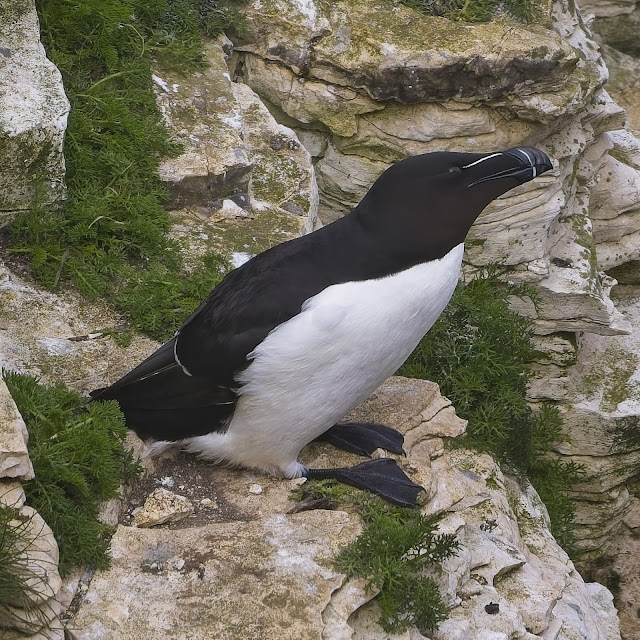RSPB Bempton Cliffs, late May 2024
We
spent two half days at RSPB Bempton. The cliffs were a fantastic spectacle
of courting and nesting birds, including Gannet, Guillemot,
Razerbill, Puffin, Kittiwake, Herring Gull, Fulmar and Rock Doves.
Locally they estimated over 300,000 birds were using the cliffs, with perhaps 3,000
Puffins.
Gannet
Gannets, specifically the Northern Gannet (Morus bassanus), are
large seabirds found along the coasts of the UK. Known for their striking
appearance, Gannets have a distinctive white plumage with black wingtips and a
yellowish head. They possess long, pointed wings and a robust, streamlined
body, adapted for high-speed diving to catch fish.
Gannets are colonial breeders, forming large, noisy colonies on cliffs
and rocky islands. The UK is home to several significant gannet colonies,
notably on the islands of Bass Rock, St Kilda, and Ailsa Craig. As of the
latest estimates, the total Gannet population in the UK is approximately
300,000 breeding pairs. This makes the UK one of the most important regions
globally for the conservation and study of these impressive seabirds.


Razorbills
Razorbills (Alca torda) are striking
seabirds found along the UK coastlines. Recognizable by their black upperparts
and white underparts, they have a distinctive, thick, black bill with a white
line along the tip. These birds are excellent swimmers, using their wings to "fly"
underwater in pursuit of fish.
Razorbills
typically nest in colonies on cliffs and rocky shores, often alongside other
seabirds such as puffins and guillemots. They prefer crevices and ledges for
nesting, where they lay a single egg per breeding season.
The UK is home
to a significant population of razorbills, with major colonies located in areas
such as the Isle of May, Skomer Island, and the Farne Islands. As of recent
estimates, the UK supports approximately 110,000 breeding pairs of razorbills.

Guillemots
Guillemots are
seabirds that inhabit the rocky cliffs and coastal regions of the UK. They have
a sleek, black and white appearance, with a dark back, head, and wings
contrasting with their white underparts. During the breeding season, they
develop a distinctive thin, white eye stripe.
Guillemots are
known for their densely packed breeding colonies, where they nest on narrow
cliff ledges. They lay a single, pear-shaped egg that helps prevent it from
rolling off the ledge. These birds are agile swimmers, diving deep into the
ocean to catch small fish and other marine prey.
The UK hosts
several large guillemot colonies, with significant populations on islands such
as Skomer, Skokholm, and the Isle of May. As of recent estimates, the UK is
home to around 1.4 million individual guillemots during the breeding season.
Puffins
Puffins,
particularly the Atlantic Puffin (Fratercula
arctica), are charming and colourful seabirds found along the UK’s
coastal cliffs and islands. These small birds are easily recognizable by their
bright orange beaks, vivid legs, and striking black and white plumage. During
the breeding season, their beaks become more brightly coloured, making them
even more distinctive.
Puffins nest
in burrows or crevices on grassy cliff tops, forming large colonies. They lay a
single egg per year and both parents take turns incubating the egg and feeding
the chick. Puffins are excellent swimmers, using their wings to dive and catch
small fish such as sand eels, which they often carry back to their nests in
their beaks.
The UK is home
to several important puffin colonies, with significant populations on islands
such as the Farne Islands, Skomer Island, and St Kilda. According to recent
estimates, the UK supports approximately 580,000 breeding pairs of puffins.






















Comments
Post a Comment